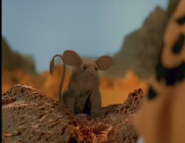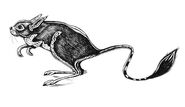A kangaroo mouse or muad'dib in Chakobsa, is a small rodent from the planet Arrakis. It was associated in the Fremen earth-spirit mythology and its figure was visible on the planet's second moon, as well as on a constellation.
Paul Atreides took the name of Muad'Dib when he was welcomed into the Fremen tribes.
This creature is admired by Fremen for its ability to survive in the open desert. Young Fremen are required to learn from their ways of survival. Thus while Paul's new Fremen name literally meant "the mouse" (which Baron Harkonnen found amusing), on a more figurative level it meant "The Teacher".
Appearances in the Dune series[]
- Dune (1965)
- Dune Messiah (1969)
- Children of Dune (1976)
Appearances in adaptations[]
The kangaroo mouse has appeared in Dune book illustrations by John Schoenherr, as well as some of the newer live-action adaptations of the Dune novels.
- Dune (1984) - There is no direct depiction of the creature, but Paul asks the Fremen about what name they call "the mouse shadow" visible on one of the moons of Arrakis. Thus, he does not choose his Fremen name directly after a desert mouse, but a formation on a moon.
- Frank Herbert's Dune (2000) - The kangaroo mouse, a CGI character, makes a brief appearance in one scene with Paul sitting still at the edge of the desert. Its design is inspired somewhat more by the jerboas of North Africa and Asia, also a species dipodid mouse, but a more distant cousin.
- Dune (2021) - The kangaroo mouse makes small appearances throughout the film, including in the scene of Paul emerging from a burried stilltent with the use of a sand compactor, and even in one of his later visions, where a compelling feminine voice reassures him and points to a family of 'little desert mice' being able to survive in the harshest desert. This seems to be a nod at later events. The kangaroo mouse is fully CGI, albeit far more hi-res and photorealistic. Once again, the design is more similar to a jerboa as well, with somewhat larger ears with prominent veins, used for body temperature cooling. A few shots depict the mouse gathering and drinking small water droplets of morning dew that slide down from its large ears, onto its cheeks.
- Dune: Part Two (2024) - The kangaroo mouse is explicitly identified by its species name when princess Irulan remarks that the nom de guerre Muad'Dib has a double meaning to the Fremen, literally "Teacher" or "Educator", but also their figurative expression for the desert kangaroo mouse. Paul chooses the aforementioned Muad'Dib moniker as in the novel, with the subtle implication his choice was partly inspired by his earlier vision, seen in the first film. The desert mouse makes a few appearances throughout the second film, including in a scene where its investigating the sandsnork of a Fremen warrior hiding beneath a layer of sand.
Gallery[]
Videos[]
Video essays[]
Analytical videos on the subject of the humble kangeoo mouse and its role in the history and culture of the Dune universe. (Beware potential spoilers.)
Behind the scenes[]
In Arabic, مؤدّب mu’addib means 'educator'.
The kangaroo mouse (Microdipodops) are two species of North American hopping mouse with larger hind limbs, from the deserts of the southwestern US. A related species is the North American kangaroo rat (not a rat, despite its name).
Similarly evolved hopping desert rodents from other continents include the jerboas of Africa and Asia (distantly related to the kangaroo mouse) and the hopping mice of Australia.
Frank Herbert likely chose the desert mouse as one of a number of North American desert species of animals and plants, as part of his research for his ultimately unpublished essay They Stopped the Moving Sands, focused on 1960s experiments with stabilising and terraforming wind-swept sand dunes in the Pacific Northwest. The essay served as one of his inspirations for writing Dune, and the even more extensive research Herbert did for the novel, with regards to desert ecosystems around the world (and Dr. Kynes' subplot of aiding secret terraforming attempts by the Fremen). As a fictional planet, Arrakis has a cosmopolitan blend of desert animals and plants from various continents of Earth, with North American, African and Asian desert life coexisting in the more livable areas of Dune's uniquely harsh ecosystem. The kangaroo mouse and a few other North American desert species in the novels are likely a tip-of-the-hat to the initially North American origins of Herbert's interest in desert environments. [1]
- This article is a stub: It may require more information.










